In the last post, I made a block from Barbara Brackman’s book American Printed Fabrics 1770-1890. This block also came from the same book. She calls it Triple Nine Patch. We also know this block as a Single Irish Chain. I have a link a quilt that was made in 1900 in browns and pinks. There was probably other colors that was fugitive which means faded because they were not stable even if the quilt had never been washed. The dyes were a vegetable dye called madder. Madder grew well here in North America and different medal salts call mordants could change the color of the madder. Madder could be dyed into pinks, red, browns, almost a black, green and lavender.
This is not a difficult block to make but you do have to keep checking your size as you sew. I watched my quarter inch seam allowance real close and didn’t run into any problems. In fact it came out 12 1/2 inches. I only need to neaten it up a little with a square up ruler. I like it when a block comes out good with as many pieces as this one had.
I chose the same colors that was featured in Barbara Brackman’s quilt. The fashion in the last half of the 19th century was for mothers to wear brown madder calico and little girls were dressed in pinks. Usually the pinks were double pinks. Double pinks were printed in little tiny dots. The closer the dots the darker the color and the farther apart the dots the lighter in color. By the time the 1890’s rolled around madder brown prints were out of fashion. The fabric still made it into quilts until around WWI.
To make this block you will need to cut:
One 3 1/2 inches square of light fabric for center of the block.
Twelve 2 inches squares of light fabric. Cut 4 each from 3 different light prints. They will be corner stones in the block.
Four 2 inches by 3 1/2 inches rectangles from one dark print.
Four 2 inches by 6 1/2 inches rectangle from a medium print.
Four 2 inches by 9 1/2 inches rectangle from a different dark print.
It actually takes more time to cut out the fabric than to sew it together. It goes together quickly. Just remember to press as you go and check your quarter inch seam allowance each time. To make this quilt, lay out your pieces in the order you want them.
Starting in the center, sew the 2 x 3 1/2 inches rectangle to opposite sides of the center block. The sew on each end of the remaining two rectangles 2 x 3 1/2 inches the four 2 inch square corner stones.
Now sew all three pieces together with the center block in the middle.
Now continue to sew from the center out the same way you did the center until you have completed all the rounds. The block should measure very close to 12 1/2 inches. Mine was just a tiny bit over so I can neaten it up.
I now have 17 blocks finished for this sampler quilt. All total I will need 36 to make a bed size quilt. I normally don’t make small quilts. I will be quilting these block on my sewing machine. So stick with me and you will see how easy it is to quilt your own bed size quilt.
This is my 100th post.
Page showing Barbara Brackman’s reproduction quilt from her book.
It is very much like the quilt from 1900.
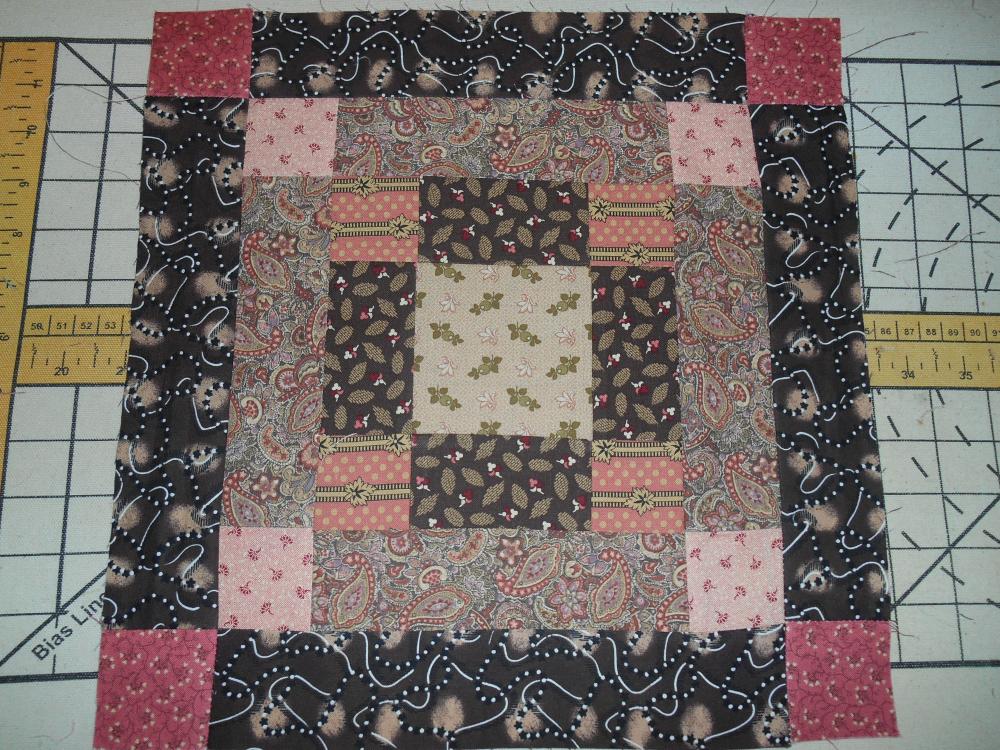
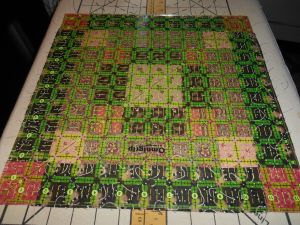
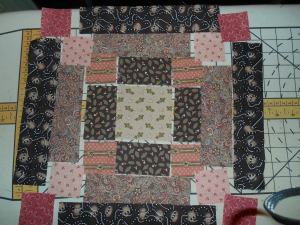
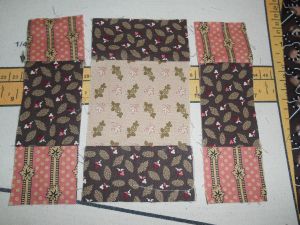
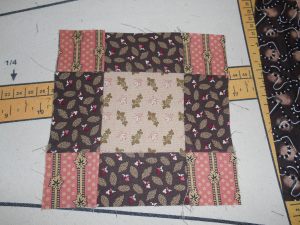
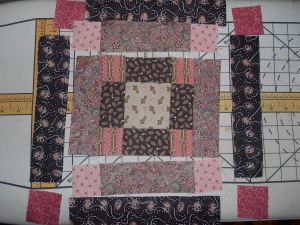
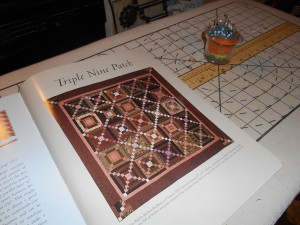
That is beautiful. I might have to try that soon!
LikeLike
The quilt caught my eye and the block that makes it. I like scrappy quilts.
Thanks for stopping in.
LikeLike
I LOVE scrappy quilts as well. I don’t throw out anything! 🙂
LikeLike
I love these colors! Very nice quilt!
LikeLike
Pink relaxes you. It is a really soothing combination. Thanks for taking the time to comment.
LikeLike
Fun to learn the source of the brown and pink quilts!
LikeLike
It really had to do with the technology that they had at the time and the dying process. These were the nicest colors besides indigo that wore pretty good. Some of the madder dyes were fugitive and overtime disappear. Fabric has an interesting history.
I will try to remember to cover more history of fabric while I do the blocks.
Thanks
LikeLike
I am looking forward to trying this block. I, too, enjoy knowing about the dying process involving the madder. Thanks for sharing. 🙂
LikeLike
You are welcome. I am working on some more blocks that I think will interest everyone from the late 19th century. So keep checking back.
Thanks for stopping by.
LikeLike
I am following your blog, so I get excited every time I see a new post. I’ll be checking back! 😀
LikeLike
Thanks for the great description of the fabrics. Love the combination of the pink and brown.
LikeLike
I find the fabric history really interesting. I too also like the pink and brown reproduction quilts. I see them sometimes in quilt shows.
Thanks for your comment.
LikeLike
I really like the way this looks. I am going to have to try one of these!
LikeLike
I liked it. Doing a sampler quilt, give you a chance to try out different blocks. There are a few of these that I may someday make a whole quilt from them.
Thank you for your comment.
LikeLike
Oh that would look really nice in a sampler. Happy Sewing!
LikeLike
Thank you for stopping in. It is goes well with the other blocks.
LikeLike
This color combination is beautiful and the patterns you chose are too. I love it
LikeLike
Thanks.
LikeLiked by 1 person